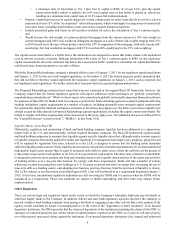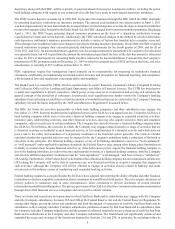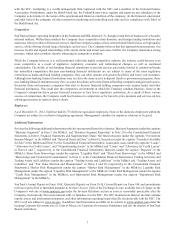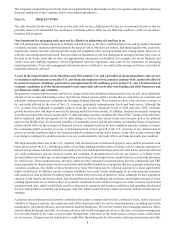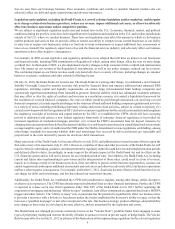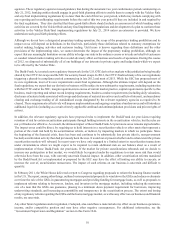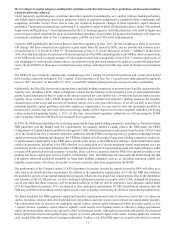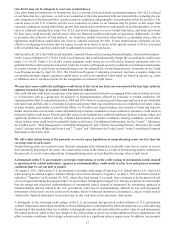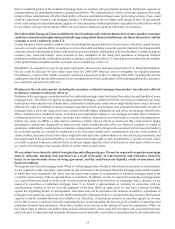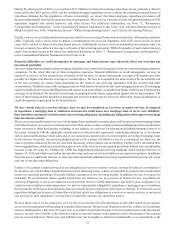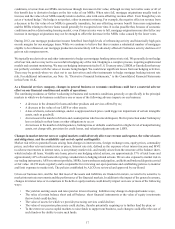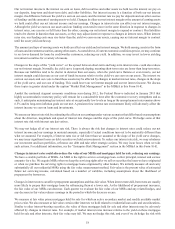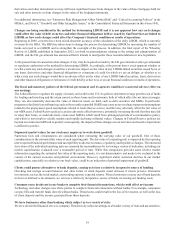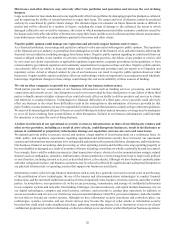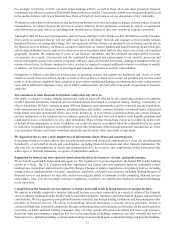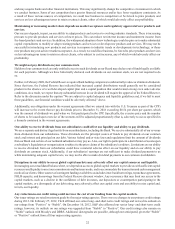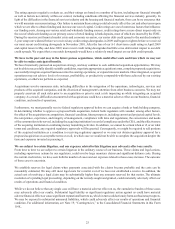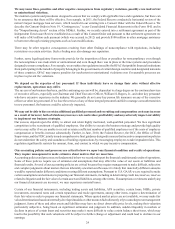SunTrust 2012 Annual Report Download - page 30
Download and view the complete annual report
Please find page 30 of the 2012 SunTrust annual report below. You can navigate through the pages in the report by either clicking on the pages listed below, or by using the keyword search tool below to find specific information within the annual report.14
deliver a material portion of the residential mortgage loans we originate into government-sponsored institutions, agencies or
instrumentalities (or instruments insured or guaranteed thereby). We cannot predict if, when or how any changes to the credit
ratings of these organizations will affect their ability to finance residential mortgage loans. Such ratings actions, if any, could
result in a significant change to our mortgage business. A downgrade of the sovereign credit ratings of the U.S. government
or the credit ratings of related institutions, agencies or instrumentalities would significantly exacerbate the other risks to which
we are subject and any related adverse effects on our business, financial condition and results of operations.
The failure of the European Union to stabilize the fiscal condition and creditworthiness of its weaker member economies
could have international implications potentially impacting global financial institutions, the financial markets, and the
economic recovery underway in the U.S.
Certain European Union member countries have fiscal obligations greater than their fiscal revenue, which has caused investor
concern over such countries ability to continue to service their debt and foster economic growth. Currently, the European debt
crisis has caused credit spreads to widen in the fixed income debt markets, and liquidity to be less abundant. A weaker European
economy may transcend Europe, cause investors to lose confidence in the safety and soundness of European financial
institutions and the stability of European member economies, and likewise affect U.S.-based financial institutions, the stability
of the global financial markets and the economic recovery underway in the U.S.
Should the U.S. economic recovery be adversely impacted by these factors, loan and asset growth at U.S. financial institutions,
like us, could be affected. We have taken steps since the 2008-2009 financial crisis to strengthen our liquidity position.
Nevertheless, a return of the volatile economic conditions experienced in the U.S. during 2008-2009, including the adverse
conditions in the fixed income debt markets, for an extended period of time, particularly if left unmitigated by policy measures,
may materially and adversely affect us.
Weakness in the real estate market, including the secondary residential mortgage loan markets, has adversely affected
us and may continue to adversely affect us.
Weakness in the non-agency secondary market for residential mortgage loans has limited the market for and liquidity of many
mortgage loans. The effects of ongoing mortgage market challenges, combined with the correction in residential real estate
market prices and reduced levels of home sales, could result in further price reductions in single family home values, adversely
affecting the value of collateral securing mortgage loans that we hold, and mortgage loan originations and profits on sales of
mortgage loans. Lower real estate prices have caused cyclically higher delinquencies and losses on mortgage-related loans.
These conditions have resulted in losses, write downs and impairment charges in our mortgage and other lines of business.
Continuing declines in real estate values, low home sales volumes, financial stress on borrowers as a result of unemployment,
interest rate resets on ARMs or other factors could have further adverse effects on borrowers that could result in higher
delinquencies and greater charge-offs in future periods, which would adversely affect our financial condition or results of
operations. Additionally, counterparties to insurance arrangements used to mitigate risk associated with increased defaults in
the real estate market are stressed by weaknesses in the real estate market and a commensurate increase in the number of
claims. Further, decreases in real estate values might adversely affect the creditworthiness of state and local governments, and
this might result in decreased profitability or credit losses from loans made to such governments. A decline in home values
or overall economic weakness could also have an adverse impact upon the value of real estate or other assets which we own
as a result of foreclosing a loan and our ability to realize value on such assets.
We are subject to certain risks related to originating and selling mortgages. We may be required to repurchase mortgage
loans or indemnify mortgage loan purchasers as a result of breaches of representations and warranties, borrower
fraud, or certain breaches of our servicing agreements, and this could harm our liquidity, results of operations, and
financial condition.
We originate and often sell mortgage loans. When we sell mortgage loans, whether as whole loans or pursuant to a securitization,
we are required to make customary representations and warranties to the purchaser about the mortgage loans and the manner
in which they were originated. Our whole loan sale agreements require us to repurchase or substitute mortgage loans in the
event that we breach any of these representations or warranties. In addition, we may be required to repurchase mortgage loans
as a result of borrower fraud or in the event of early payment default of the borrower on a mortgage loan. Likewise, we are
required to repurchase or substitute mortgage loans if we breach a representation or warranty in connection with our
securitizations, whether or not we were the originator of the loan. While in many cases we may have a remedy available
against the originating broker or correspondent, often these may not be as broad as the remedies available to a purchaser of
mortgage loans against us, and we face the further risk that the originating broker or correspondent may not have the financial
capacity to satisfy remedies that may be available to us. Therefore, if a purchaser enforces its remedies against us, we may
not be able to recover our losses from the originating broker or correspondent. We have received a number of repurchase and
indemnity demands from purchasers. These have resulted in an increase in the amount of losses for repurchases. While we
have taken steps to enhance our underwriting policies and procedures, these steps will not reduce risk associated with loans
sold in the past. If repurchase and indemnity demands increase materially, our results of operations may be adversely affected.


